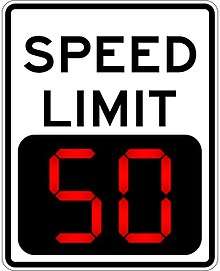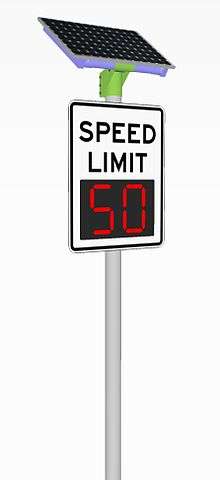Smart traffic light
Smart traffic lights or Intelligent traffic lights are a vehicle traffic control system that combines traditional traffic lights with an array of sensors and artificial intelligence to intelligently route vehicle and pedestrian traffic.[1] They can form part of a bigger intelligent transport system.


Research
A technology for smart traffic signals has been developed at Carnegie Mellon University and is being used in a pilot project in Pittsburgh in an effort to reduce vehicle emissions in the city. Unlike other dynamic control signals that adjust the timing and phasing of lights according to limits that are set in controller programming, this system combines existing technology with artificial intelligence.
The signals communicate with each other and adapt to changing traffic conditions to reduce the amount of time that cars spend idling. Using fiber optic video receivers similar to those already employed in dynamic control systems, the new technology monitors vehicle numbers and makes changes in real time to avoid congestion wherever possible. Initial results from the pilot study are encouraging: the amount of time that motorists spent idling at lights was reduced by 40% and travel times across the city were reduced by 25% [2].
Possible Benefits
Companies involved in developing smart traffic management systems include BMW and Siemens,[3] who unveiled their system of networked lights in 2010. This system works with the anti-idling technology that many cars are equipped with, to warn them of impending light changes. This should help cars that feature anti-idling systems to use them more intelligently, and the information that networks receive from the cars should help them to adjust light cycling times to make them more efficient.
A new patent appearing March 1st, 2016 by John F. Hart Jr. is for a "Smart" traffic control system that "sees" traffic approaching the intersections and reacts according to what is needed to keep the flow of vehicles at the most efficient rate. By anticipating the needs of the approaching vehicles, as opposed to reacting to them after they arrive and stop, this system has the potential to save motorist time while cutting down harmful emissions.
Romanian and US research teams believe that the time spent by motorists waiting for lights to change could be reduced by over 28% with the introduction of smart traffic lights and that CO2 emissions could be cut by as much as 6.5%.[4]
A major use of Smart traffic lights could be as part of public transport systems. The signals can be set up to sense the approach of buses or trams and change the signals in their favour, thus improving the speed and efficiency of sustainable transport modes.
Obstacles to widespread introduction
The main stumbling block to the widespread introduction of such systems is the fact that most vehicles on the road are unable to communicate with the computer systems that town and city authorities use to control traffic lights. However, the trial in Harris County, Texas, referred to above, uses a simple system based on signals received from drivers' cell phones and it has found that even if only a few drivers have their phone switched on, the system is still able to produce reliable data on traffic density. This means that the adoption of smart traffic lights around the world could be started as soon as a reasonable minority of vehicles were fitted with the technology to communicate with the computers that control the signals rather than having to wait until the majority of cars had such technology.
The first experiment
On Tuesday the 30 of July 2019 the first experiment of a traffic signal regulated by 100% "connected" vehicles was carried on at University of Calabria (Unical) with the help of common commercial smart phones by a team of researchers working for Unical and the innovative Start Up SOMOS[5][6][7].
Simpler systems
Meanwhile, in the United Kingdom, lights that change to red when sensing that an approaching motorist is traveling too fast are being trialled in Swindon[8] to see if they are more effective at reducing the number of accidents on the road than the speed cameras that preceded them and which were removed following a council decision in 2008. These lights are more focused on encouraging motorists to obey the law but if they prove to be a success then they could pave the way for more sophisticated systems to be introduced in the UK.
Previous research
In addition to the findings of the Romanian and US researchers mentioned above, scientists in Dresden, Germany came to the conclusion that smart traffic lights could handle their task more efficiently without human interface.[9]
See also
References
- "'Smart' traffic signals cut air pollution in Pittsburgh". McCain, Inc. September 25, 2012. Archived from the original on October 10, 2013. Retrieved September 28, 2012.
- "Smart and Scalable Urban Signal Networks". Retrieved 7 November 2017.
- Michael Graham Richard (March 18, 2010). "Networked Traffic Lights Could Save Time, Fuel, and Lives". Narrative Content Group. Retrieved October 21, 2011.
- Max Glaskin (February 12, 2008). "Could smart traffic lights stop motorists fuming?". Retrieved October 21, 2011.
- "The first smart traffic signal experiment in the world is a great success" (PDF). 30 July 2019.
- Astarita, Vittorio (2019-11-28). "INTER TRAFFIC WORLD 2020". journal-download.co.uk. Retrieved 2019-11-28.
- Astarita, Vittorio; Giofré, Vincenzo Pasquale; Festa, Demetrio Carmine; Guido, Giuseppe; Vitale, Alessandro (January 7, 2020). "Floating Car Data Adaptive Traffic Signals: A Description of the First Real-Time Experiment with "Connected" Vehicles". Electronics. 9 (1): 114. doi:10.3390/electronics9010114. Retrieved June 15, 2020.
- Millward, David (May 19, 2011). "Smart traffic lights to stop speeders". The Telegraph.
- "Self organizing smart traffic lights offer significant reductions in waiting times and fuel consumption". August 20, 2008. Retrieved October 21, 2011.